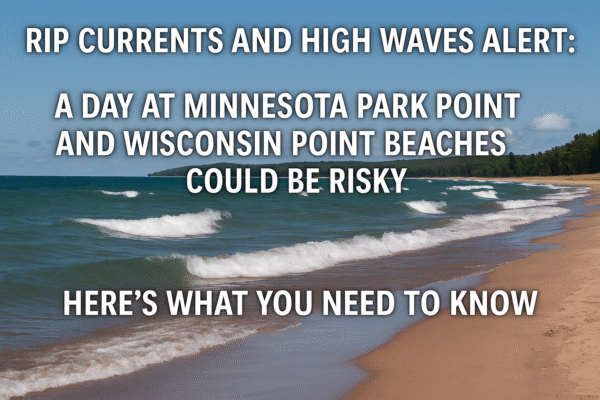On August 17, 2025, the National Weather Service (NWS) Duluth Office issued a Beach Hazards Statement for the popular Park Point Beach in Duluth, Minnesota, and Wisconsin Point Beach in Superior, Wisconsin. This advisory is effective through 10:00 PM CDT and has been prompted by forecasts of strong rip currents and elevated wave activity along Lake Superior’s shoreline.
These conditions pose significant risks to swimmers and beachgoers, prompting local authorities to caution tourists, especially those unfamiliar with the dynamics of the Great Lakes. As the beach tourism season peaks in August, the alert has widespread implications for regional safety and tourism.
Understanding the Current Risk at Park Point and Wisconsin Point
The unique geography of Lake Superior often contributes to rapidly changing weather and wave conditions. Today’s combination of brisk onshore winds and choppy waves has created an ideal scenario for the formation of rip currents—fast-moving channels of water that can pull swimmers away from the shore unexpectedly.
According to the NWS advisory, wave heights are expected to exceed 3–5 feet, with frequent sets crashing in rapid succession. Even experienced swimmers may find it difficult to regain footing once caught in these powerful surges.
What Are Rip Currents—and Why Are They So Dangerous?
Rip currents are narrow, powerful water channels that move from the shore out into the lake. Unlike undertows, which pull swimmers under, rip currents sweep swimmers horizontally away from the beach. The best survival tactic, as advised by the U.S. Lifesaving Association, is to swim parallel to the shoreline until the current weakens, then swim back toward land.
Today’s hazard warning makes this knowledge particularly vital for tourists, many of whom may not be familiar with Great Lakes water behavior.
Tourism Impact: A Setback for Duluth and Superior’s Summer Season
Both Park Point and Wisconsin Point are renowned for their natural beauty, recreational opportunities, and summer tourism appeal. Park Point is a 7-mile sandbar, the longest freshwater sandbar in the world, and is heavily visited in peak season. Wisconsin Point, with its rich bird habitats and scenic views, draws thousands of nature lovers each year.
Local tourism officials are concerned that the hazard alert may deter visitors in the short term. While beach rentals, surf shops, and cafes rely on high foot traffic in August, they are also encouraging guests to explore inland alternatives.
Safer Alternatives for Tourists in Duluth and Superior
While swimming is currently off-limits, there’s no shortage of attractions for those visiting the Lake Superior region:
- Duluth’s Aerial Lift Bridge: A historic engineering marvel and iconic photo spot.
- Lakewalk Trail: Perfect for scenic hikes or cycling along the lake’s edge.
- Great Lakes Aquarium: A family-friendly spot showcasing regional aquatic life.
- Superior Entry Lighthouse: A serene location for photography and quiet reflection.
These attractions allow tourists to safely enjoy the region while waiting for conditions at the beach to improve.
Staying Safe: Tips from the National Weather Service
The NWS and local emergency management teams have issued the following safety tips:
- Avoid entering the water until conditions are deemed safe by local authorities.
- Observe posted signs and flags that indicate swimming hazards.
- Stay within designated swimming areas, and always swim with a buddy.
- Keep children away from the shoreline, as rogue waves can be unpredictable.
- Check beach conditions regularly on the NWS Duluth website or via local lifeguard stations.
Local emergency responders remain on alert, patrolling the beaches and ready to assist if necessary.
What’s Next? Forecast and Outlook for Beachgoers
Weather models suggest that conditions will stabilize by August 18, allowing tourists to return to the water in safer conditions. The NWS will continue to monitor wave patterns and wind speeds and will update the Beach Hazards Statement if needed.
Visitors planning to swim later in the week should still check local advisories before heading out. Apps such as NOAA’s Great Lakes Beach Forecast or regional alerts via ReadyWisconsin and Minnesota DNR are helpful tools for planning safe outings.
Conclusion: Enjoying the Great Lakes Safely
While today’s hazard alert may put a damper on swimming plans, it serves as a timely reminder of Lake Superior’s power. Responsible tourism and attention to safety advisories are essential to ensure a fun and secure experience for all visitors.
The communities of Duluth and Superior remain committed to welcoming tourists with open arms—and with an eye on safety. Whether you’re a seasoned adventurer or a first-time visitor, there’s plenty to explore, even when the water says “not today.”
For more travel news like this, keep reading Global Travel Wire


















